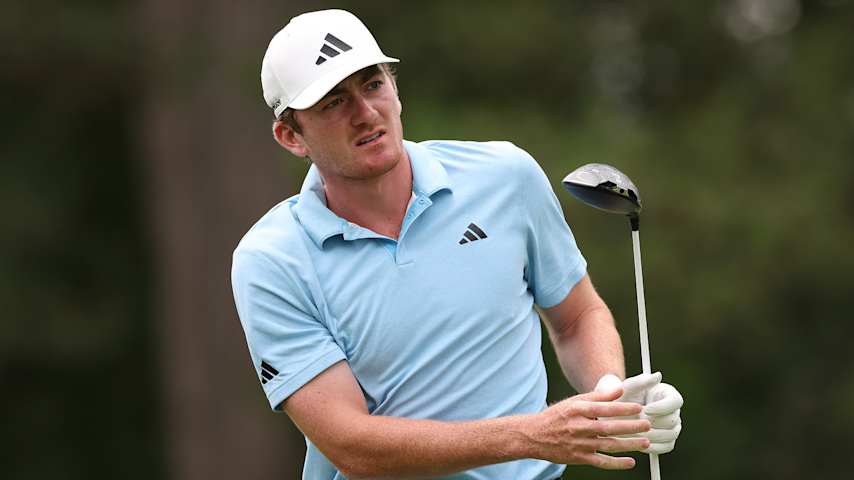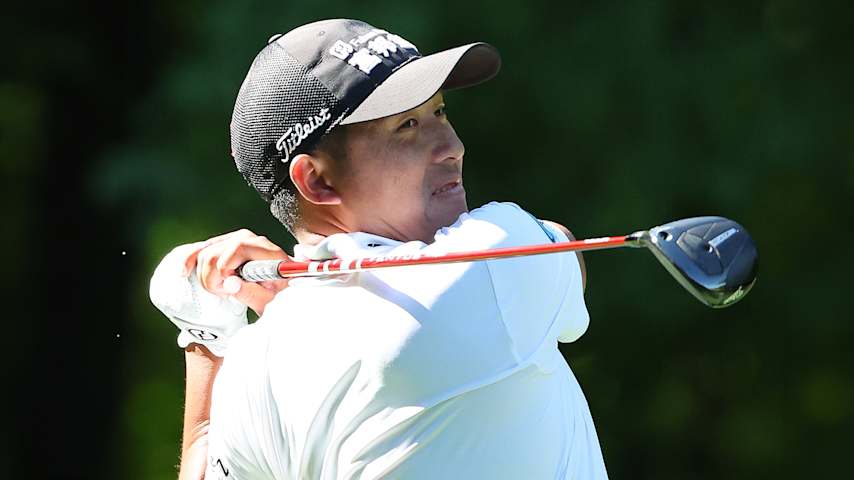Five things to know: TPC Deere Run
7 Min Read

Recapping Sepp Straka's win at John Deere Classic
Written by Craig DeVrieze
It was the ultimate “aha” moment.
From the time the small Quad Cities first landed a PGA TOUR event in 1971, it made sense that Deere & Company, a Moline, Illinois-based Fortune 100 company, should serve as title sponsor.
The challenge was making it make business sense for Deere.
Over its first 15 years of hard-fought existence, the tournament worked through two title sponsors and racked up a barrel of red ink, always trying to land that obvious choice.
Finally, it was Deere or bust in March of 1996, when a desperate Hail Mary – one that seems obvious in retrospect – led to the creation of TPC Deere Run and what is today the second longest-running title sponsorship on TOUR.
1. A win-win arrangement
When then-PGA TOUR Senior Vice President for Tournament Business Affairs Duke Butler III and a pair of tournament reps visited with a trio of Deere executives, several compelling reasons were on the table for the hometown company to consider.
Butler still swears his clinching argument came to him on the spur of the moment, just as the assembled Deere representatives stood up to say thanks but no thanks. As much as anything, company leaders at the table since have said, Deere feared that a short-lived, non-business-supported arrangement might result in the TOUR leaving the decades-old tournament behind, thus giving the farm-implement manufacturing giant a black eye in its hometown.
“And so I said, ‘I can think of two reasons why we wouldn’t leave here,’” Butler recalled. “Deere undoubtedly owns a lot of land around here and, if you were agreeable to it, we would build a TPC course here for you in the Quad Cities. And if you did, that course could be maintained with Deere equipment, and we could make a licensing agreement where you could maintain all the TPC courses in the United States and around the world.
“There was about 30 seconds of silence, and they said, ‘Could you sit back down?’”
In a matter of 13 months, the deal was in place and a golf course located within a mile of corporate headquarters on a horse farm long owned by the great-great-granddaughter of John Deere himself, was on the drawing board.
In that “aha” moment, the John Deere Classic and TPC Deere Run were born.
Last May, Deere agreed to a three-year extension, and at the center of a long and mutually successful relationship is the licensing agreement that helped what was then a fledgling golf and turf equipment division grow into a worldwide golf industry leader.
2. A magical piece of property
The horse farm that once belonged to Patricia “Tish” Hewitt, the great-great-granddaughter of John Deere, was coincidentally on the market as the deal came together in 1996.
Hewitt had died in 1992. Per her wishes, widower and former Deere president and CEO William Hewitt and his three children were looking for a buyer — and not just any buyer. The family wanted someone who would keep the 388 acres of land virtually as pristine as it was in 100 B.C., when the Hopewell culture, among the North American continent’s first settlers, hunted mastodons and mammoths on the river bottoms below.

A view of No. 16 at TPC Deere Run. (Andrew Redington/Getty Images)
The Hopewell had come to stay, leaving no fewer than six sacred burial mounds in their wake on the grounds purchased by Deere.
The course that TPC Deere Run designers D.A. Weibring and Chris Gray conceived is carefully routed around those hidden-in-the-brush mounds, each identified in an architectural study co-commissioned by the Hewitts’ daughter and Deere & Company prior to course construction.
The design team still had ample routing options because a critical Hewitt family stipulation was that any development not include housing. It was nirvana for a golf course architect.
“Normally, you talk about constraints and problems,” said Gray, then a member of the TOUR’s TPC network design group. “With this site, you talk about opportunities. There are probably 10 good golf courses on this site. We’re only doing one of them.”
Noted Vernon Kelly, president of the TOUR’s Golf Course Properties division when TPC Deere Run opened in 2000, “I have been involved with every TPC as far as sites. This is certainly one of the best, if not the best, I’ve ever seen. From the time we saw that property, the project took on a new meaning.”
3. Birdies, exciting finishes abound
TPC Deere Run is known for allowing low scores. More than half of the 23 winners on the course have matched or exceeded 20-under par on the par-71 track, which is open to the public.
That includes 2018 champion Michael Kim, who finished with a 27-under 257, the seventh-lowest score in TOUR history.
Kim won by a tournament-record eight shots, a genuine runaway victory at a course where exciting finishes have been the norm. Seven John Deere Classics have been won by a single shot and another seven were decided in playoffs.
The latter includes a pair of sudden-death victories by Jordan Spieth (2013 and 2015) and one by hometown favorite Zach Johnson in 2012.

Jordan Spieth’s incredible bunker shot at 2013 John Deere
Steve Stricker closed out the last of his three straight Deere wins with an epic walk-off birdie in 2011. A then-teenaged Spieth birdied five of his last six holes – including a bunker hole-out on the 72nd hole – to join a playoff with Johnson and David Hearn in 2013. Two years later, Spieth rallied from four shots back with six holes to play, then topped Tom Gillis on the second hole of sudden death in 2015.
In the first round of 2010, Stricker carded an afternoon round of 60 – and trailed leader Paul Goydos by a shot. Stricker set a TOUR record with his score of 188 (60-66-62) over the first three rounds and led by six shots. He won by a pair when Goydos hit an approach to the final hole into the water.
A three-time Quad Cities winner when the event was played at Oakwood Country Club, Weibring has tweaked Deere Run several times but said not every player shares McIlroy’s aversion to low scoring.
“When Goydos shot the 59, I went to Davis Love (III) and a bunch of guys who were here and said, ‘Guys are going pretty low. Should we look for a few more tees?’” Weibring remembered. “And they said, ‘No. The golf course is great. It’s fun. You have to hit good shots. Don’t touch it.’”
4. Expensive real estate
TPC Deere Run debuted at 7,183 yards in 2000 and had grown to 7,268 yards by 2007. Only two years in, the relatively benign eighth hole was increased from 374 yards to 428 when Weibring “found” a new tee beyond the course’s boundaries.
The circle of land the pros still launch from today may be the priciest piece of real estate, square-footage-wise, in Silvis' history. Newly retired tournament director Clair Peterson remembers the price for that 15-by-15-foot tee box being $25,000.

A scenic view of No. 8 at TPC Deere Run. (Andrew Redington/Getty Images)
And this just in: “We’re trying to take it back further now,” Weibring said last week. “I’d like to pull it back 25 to 30 yards.”
Better bring the checkbook.
5. Captains chart their course
Few players have enjoyed a run of success like Stricker at TPC Deere Run.
The man from nearby Madison, Wisconsin, posted top-five finishes in half his 14 starts at TPC Deere Run from 2004-17. In 24 rounds from 2009-14, the most recent U.S. Ryder Cup captain averaged 66.2 shots, bettered par in 22 consecutive rounds, and shot in the 60s in 20.
Behind his three consecutive wins from 2009-11, Stricker finished T5, T10 and T11. In 2017, at age 50, he tied for fifth.
And yet, the former Ryder Cup captain could give the past captain a run for his TPC Deere Run money.
A native of even closer Cedar Rapids, Iowa, Johnson is virtually a hometown hero at the John Deere Classic. In his first seven starts at TPC Deere Run, the two-time major champion was less than heroic, missing three cuts and never finishing higher than a tie for 20th in 2004.
Then he caught fire.
From 2009-17, Johnson logged seven top-five finishes, including a win in his so-called “fifth major” in 2012. From 2009 through the opening round of 2016, Johnson logged 29 straight rounds in the 60s and averaged 66.5 per round. From 2009 through 2015, he finished outside the top three just once (T21, 2010).
The lesson is clear. If you want to be a U.S. Ryder Cup captain, maybe dominate at TPC Deere Run.






